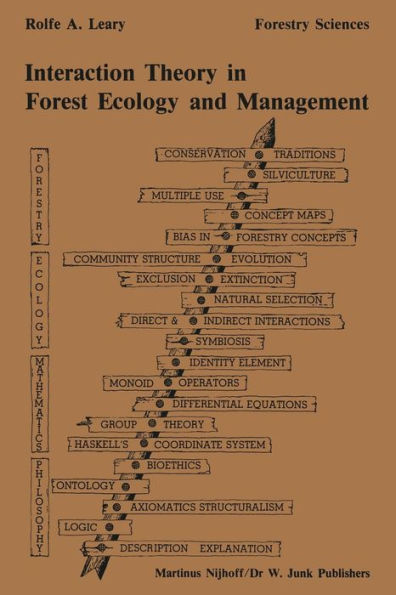5
1


Paperback(Softcover reprint of the original 1st ed. 1985)
$109.99
-
PICK UP IN STORECheck Availability at Nearby Stores
Available within 2 business hours
Related collections and offers
109.99
In Stock
Overview
As J understand it, a book Preface is where the author explains to the reader how the book in hand came about, something of the personal reasons for having inflicted such extended duress on one's self to complete the manllscript. and other items that are fit to say but do not fit in the text. This book had its conceptual beginnings in the 1970's wit h my 'studies in scientific synthesis at the North Central Forest Experiment Station, St. Paul, Minnesota. Ours is, clearly, the age of analysis. But, I felt, we must soon begin frameworks for synthesis, or a synthesis would never be possible. In short, I hoped to develop 'interaction' as an integrative principle in forestry. As work progressed on the manuscript, other subthemes developed. First, there was the vague feeling on my part that the forestry profession was losing ground in the contest to see who should manage the forests of the world. This was happening not because foresters do not know how to manage forests in a reasonable manner, but because the public seemed to be loosing faith in the judgement of foresters as professional, responsible, wise land managers. Several well-known incidents of poor judgement in timber harvesting methods on national forests in the United States did little to help the forester's image.

Product Details
| ISBN-13: | 9789401087797 |
|---|---|
| Publisher: | Springer Netherlands |
| Publication date: | 12/25/2011 |
| Series: | Forestry Sciences , #19 |
| Edition description: | Softcover reprint of the original 1st ed. 1985 |
| Pages: | 219 |
| Product dimensions: | 6.30(w) x 9.45(h) x 0.02(d) |
Table of Contents
I: Setting the Stage, ExactIy.- 1: The Science of Forest Science.- A. Language, Construct, Object.- B. Category Inventories.- C. Within Category Relations.- D. Between Category Relations.- E. Research Problems.- 2: Interaction, “Interaction” , ‘Interaction’.- A. Interaction — The Event.- B. “Interaction” — The Concept.- C. ‘Interaction’ — The Term.- D. Research Problems.- 3: The Roles of Spontaneous and Induced Change in Some Forestry Concepts.- A. Site and Related Concepts.- B. Measures of Space Occupancy by Trees.- C. Accretion.- D. Assessing the Animal Producing Power of Forests.- E. Discussion.- F. Research Problems.- 4: Interaction Geometry.- A. Fundamental Parts.- B. Combining Fundamental Parts.- C. Mapping Experimental Results.- D. A Wrinkle in Interaction Space.- E. Haskellian Coordinates as a Fourth Order Predicate.- F. Research Problems.- II: Analysis.- 5: Haskellian Coordinates in Analysis — Searching For Pattern.- A. Competition (-, - ).- B. Prey-Predator (-, +).- C. Parasite-Host (+, - ).- D. Plant-Herbivore (-, +).- E. Pattern and Expectation.- F. Research Problems.- 6: Patterns of Interaction in Mixed Forest Stand Dynamics.- A. Historical Review.- B. Role of Presuppositions in Study Design and Analysis.- C. Example Mixed Stand Dynamics.- D. Controlling Interactions by Thinning.- E. Geometrizing Silviculture.- F. Research Problems.- III: Synthesis.- 7: Haskell’s Coordinate System in Synthesis.- A. Synthesis in General.- B. Integrative Principles.- C. Forms of Scientific Synthesis.- D. Haskell’s Coordinate System and the Mathematical Form of Synthesis.- E. Discussion.- F. Research Problems.- 8: “Interaction” in a System of Concepts.- A. Valence of “Interaction”.- B. A cummulative level structure.- C. “Interaction” and Concept Maps.- D. Summary.- E. Research Problems.- IV: Structure Evolution.- 9 : A Theory of Indirect Effects and Implications for the Natural Selection of Community Structures.- A. Community, Structure, Natural Selection.- B. The Set, the Operator, the Structure.- C . A Theory of Indirect Interactions.- D. Discussion of Theorems.- E. Natural Selection Levels in Community Interaction Structure Evolution.- F . Community Interaction Structure Evolution.- G . Summary.- H . Research Problems.- 10: Natural Selection of Interaction Structures in Communities With Many Populations.- A. Representing Structure Analysis Results.- B. Interaction Structure Analysis Methods.- C . Interpreting the Analysis.- D. Toward a New Exclusion Principle.- E. Discussion.- F. Summary.- G . Research Problems.- V : Decision-making.- 11: A Clarification and Extension of Multiple Use.- A. ‘Multiple use’ , “Multiple use” , Multiple use.- B. Analyzing of “Multiple use”.- C. Extending the Concept of Multiple Use.- D. Research Problems.- 12: Conservation Traditions.- A. Economic Efficiency Tradition.- B. Ecologic Tradition.- C. Biocentric Tradition.- D. Summary.- E. Research Problems.- 13 : Toward a Synthesis of Conservation Traditions.- A. The Central Problem.- B. Biocentric-Ecologic.- C. Ecologic-Economic.- D. Biocentric-Ecologic-Economic.- E. Observations.- F . Research Problems.- Literature Cited.From the B&N Reads Blog
Page 1 of
